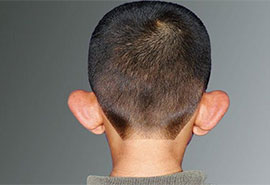
Prominent ear is a non-functional, purely 'aesthetic' problem. However, sometimes this problem can turn into a very serious psychological trauma. As we know, children can be 'cruel' to each other. Therefore, a child who has prominent ears may have social problems, and may isolate himself or herself. We are also happy when a female patient, who has always been trying to cover her ears by her long hair says after the operation, "Now I can have short hair!’’
Prominent ear is the name given to the deformity in which the ear is excessively protruding from the head, and although some other factors also contribute, the most important reason is the underdevelopment of the ear fold, which is called the 'anthelix' in the medical language. Although it is usually bilateral, it can also be unilateral or asymmetrical. Normally, the auricle reaches 90% of its adult size by the age of 5 years. Considering the psychological factors mentioned above, surgical correction of prominent ear is ideal for children after the age of 5 and before primary school.
Although prominent ear surgeries can be performed with general or local anesthesia in adults, they are performed only under general anesthesia in children. Many methods have been described for this surgery. Although I add some modifications according to the characteristics of the ear, the basic method I use is the 'Mustardé' method. In this technique, some skin is removed from behind the ear, and an anthelix fold is created with permanent sutures. Additionally, a suture through the mastoid bone periosteum to approximate further the ear towards the head. The incision behind the patient's ear is closed with absorbable stiches. If necessary, the same procedure is performed on the opposite ear, and ear dressing is done.
The following day after the surgery, the dressing is opened and the ear is checked, and the dressing is redone. The ear is left open at the end of the first week. Antibiotic ointments can be applied on the stitches behind the ear. It is recommended that the patient use as many tennis bands as he can wear during one month. This is to support the auricle to stay in the position it was brought in.
Complications that may occur after prominent ear surgery (otoplasty) include bleeding, collection of blood in the ear (haematoma), infection, skin loss, aesthetic problems such as ‘telephone ear deformity’, narrowing of the entrance of the external ear canal, and recurrence of the prominent ear. These complications are not common. In case of a recurrence, the patient can be reoperated.


